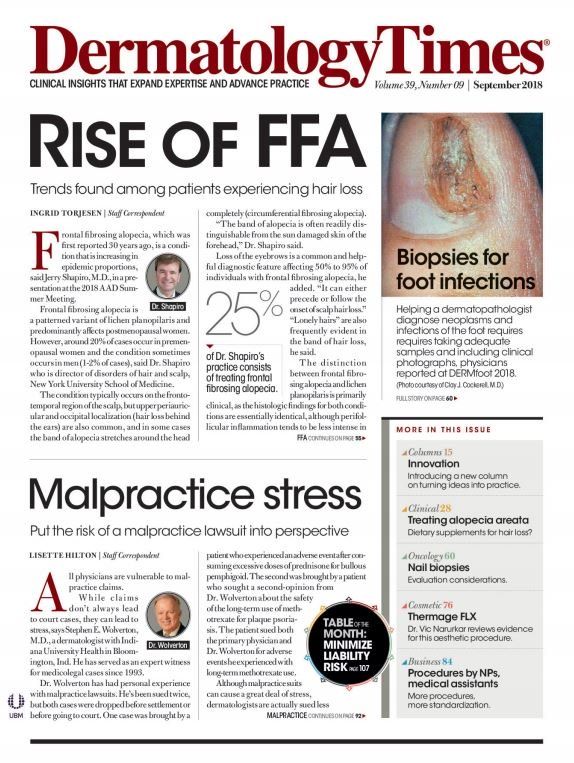- Acne
- Actinic Keratosis
- Aesthetics
- Alopecia
- Atopic Dermatitis
- Buy-and-Bill
- COVID-19
- Case-Based Roundtable
- Chronic Hand Eczema
- Drug Watch
- Eczema
- General Dermatology
- Hidradenitis Suppurativa
- Melasma
- NP and PA
- Pediatric Dermatology
- Pigmentary Disorders
- Practice Management
- Precision Medicine and Biologics
- Prurigo Nodularis
- Psoriasis
- Psoriatic Arthritis
- Rare Disease
- Rosacea
- Skin Cancer
- Vitiligo
- Wound Care
Publication
Article
Dermatology Times
CMS proposes new reimbursement guidelines: Are they kidding?
Author(s):
A new Centers for Medicaid and Medicare Services plan for payment for evaluation and management services (E/M) has been proposed and CMS is currently accepting comments through 5 p.m., Sept. 10. The new rules would apply to all E/M services delivered after Jan. 1, 2019.
(©Dizain/Shutterstock.com)

Dr. Levine

A new Centers for Medicaid and Medicare Services plan for payment for evaluation and management services (E/M) has been proposed and CMS is currently accepting comments through 5 p.m., Sept. 10. The new rules would apply to all E/M services delivered after Jan. 1, 2019.
The gist of the new rules is that there would be only one E/M category for any service with at least an E/M level of the present 99202 for new patients or 99212 for return patients. The payment would be about $135 for new office visits regardless of the complexity of the service rendered and about $93 for return visits. For example, an oncologist seeing a new cancer patient with all of the difficulties of reviewing the old medical records, doing a complete examination and ordering appropriate laboratory tests would be paid the same as a dermatologist evaluating someone with a seborrheic keratosis.
The rationale for this change in payment is that there will be a reduced paperwork burden on the treating medical practitioner, since every little detail would not need to be documented in the medical record in order to maximize payment. According to CMS officials, this would allow physicians more time to spend with their patients. They estimate that these new rules would save an estimated 51 hours of clinic time per year.
CMS reports that very few physicians will realize major changes in income, although a few specialties will be affected differently than the others. Supposedly, obstetricians would benefit greatly while dermatologists, rheumatologists and podiatrists would be the most adversely affected.
Let us start the analysis of this plan by examining the ways in which it might impact dermatology. In spite of the predictions of lower incomes for dermatologists, it is my view that most of us will benefit handsomely financially. I do not know how other dermatologists bill for E/M services, but I cannot recall a single instance where I have ever been paid $135 for an initial evaluation. Under the proposed plan, I will almost certainly earn more money. In addition, the clinic notes of most dermatologists will be much easier to prepare because I am pretty sure that most will no longer document the minimal abnormalities (skin tags, etc.), which currently invite a higher level of E/M service to be billed.
What happens when a patient with a complicated dermatologic problem consults with one of us? I now spend a fairly large portion of my time caring for these people. With the new rules, there might be a financial incentive to refer them to the local university dermatology department and let that institution struggle to remain financially viable with what would be a significant decrease in payment for the care that they deliver. Apparently, CMS has indicated that there will be “add-on payments,” mostly to primary care providers and “some others” to reduce the amount of lost income that they incur.
It appears that most dermatologists will benefit financially with this new system. But wait, I thought that medical care was supposed to center around the needs of the patients and not around the best interests of medical practitioners. Let us consider a few worst-case scenarios:
• A patient with multiple dermatologic problems is informed that his physician will only address one issue per visit. This would certainly benefit the physician but could be a major hassle for the patient having to return multiple times to have all of his problems addressed, each time with a new co-pay.
• The new payment system promises that the physicians will have more time to spend on individual patient care. Although it would be nice to imagine that the doctor would use all of the time saved in documentation to spend on increased time and attention to each of his patients. I would guess that it is more likely that the physician will either leave work earlier each day or will see additional numbers of patients with the attendant increased income. A recent article in The New York Times about the E/M changes featured a few other possible unintended consequences with the new payment system. These might affect the entire medical care system.
• Many providers of complex medical services will stop participating in Medicare altogether. This would greatly reduce the options that many Medicare enrollees would have for quality care.
• Erroneous or fraudulent claims might be paid more often because physicians would be submitting less information to document the services provided (that is what “cutting red tape” is all about).
• Medical students will understand the long-term implications of the payment proposals and might choose against medical disciplines with high intensity encounters such as internal medicine or family medicine, the ones which will be most needed in the future.
As you can imagine, it is my view that the new E/M payment system will be a financial boon to most dermatologists but would be a disaster for our patients and for the medical care system as a whole. I am hopeful that the American Academy of Dermatology and other influential groups will persuade CMS to reconsider this poorly designed program.

Newsletter
Like what you’re reading? Subscribe to Dermatology Times for weekly updates on therapies, innovations, and real-world practice tips.
























